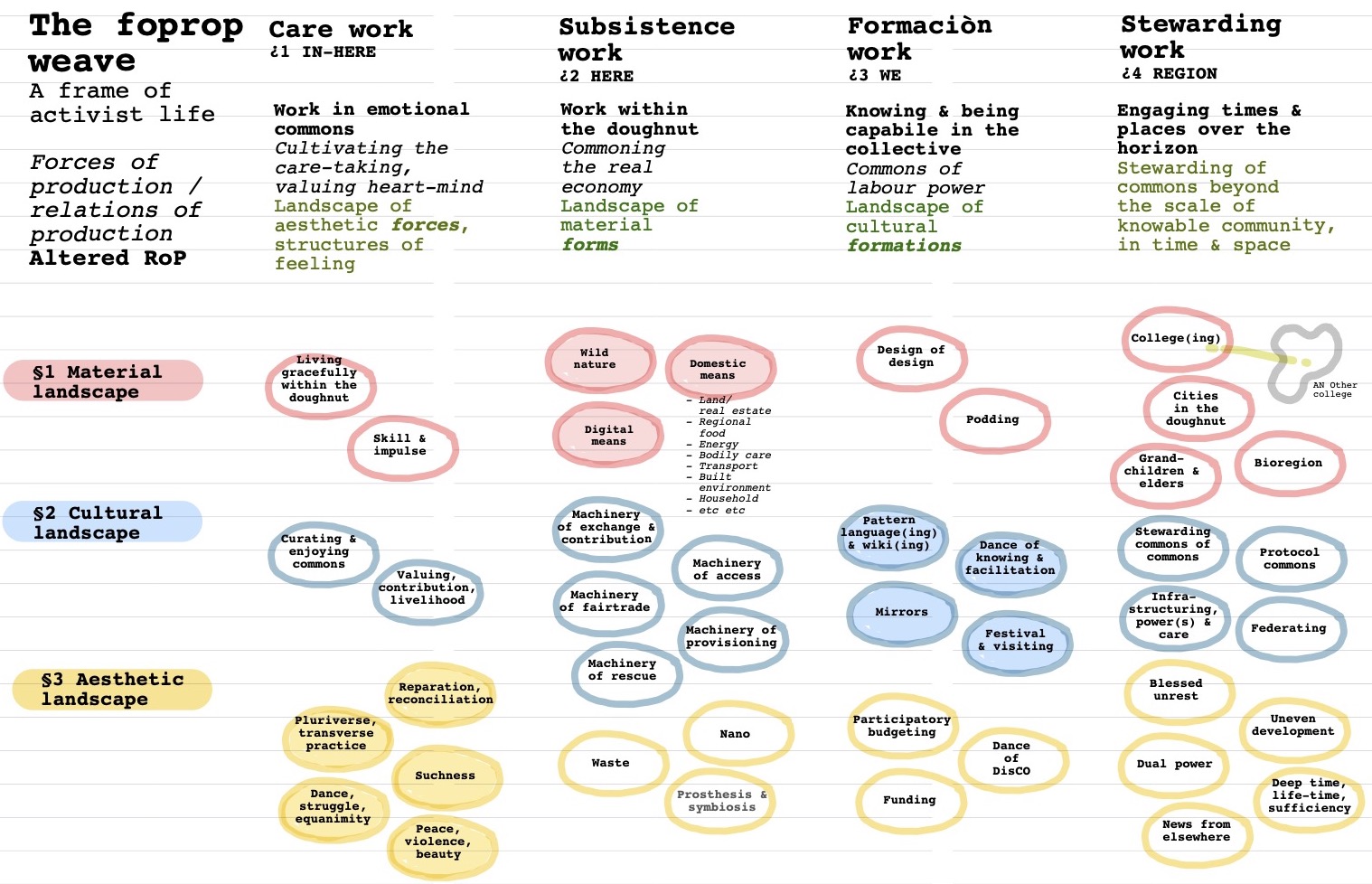Here we describe how the landscapes of practice and the zones of reach can generate a 'weave' of imaginative spaces that is rich enough to be a container for a pattern language of activist practice in making a living economy.
What is foprop? An acronym: see foprop - Forces of production, relations of production
# The foprop weave
This 'weave' is constructed as a conceptual, imaginative and practical space, from two intrinsically rich dimensions:
With landscapes running across (the weft) and zones running down (the warp), this generates a living, animated 'fabric' of twelve regions practice.
Each region can hold any number of patterns. We organise the patterns in families; hopefully a small enough number of families for them to be held in imagination, without seriously limiting the scope of the patterns that exist in the weave.

§landscape (weft) and ¿zones (warp) The foprop weave
In the same way that warp is put on the loom first, with weft threads woven across to create a substantial coherent fabric, so in the foprop weave we adopt the warp - ¿zones - as the primary focus. Families are organised within one or another ¿zone. However, within the zone, a family will have a predominant orientation to one or another landscape.
Thus patterns can 'affiliate' with others in the same zone, and 'resonate' with patterns in other zones. This is not a simple fabric composed of adjacent units; it's hyper-dimensional. More, in fact, like a mycelium than a grid or matrix.
# A 'container' - for what? What can a collection of patterns contain?
This is a deep question about practices of knowing, and the ways in which particularity can be maintained, in *'a voice from somewhere'*. We'll say more in a separate wiki on pattern language(ing) and a wiki on 'the dance of knowing'. Pattern language and the foprop weave Tools for conviviality
Here we outline an evolving, distributed, collective practice of pattern language(ing) that generates and sustains the foprop weave.
Tools for conviviality is a framework for thinking about and mobilising ways of knowing and organising. Here we develop a perspective on altered relations of cultural production - practices of knowing and capability - in terms of tools for conviviality. We describe the dance of knowing that is part of making a living economy, and the concerns of design justice, stewarding, structures of feeling, and other dynamics of power that are wrapped up in conviviality and its institutions.
For some notes on particularity, see Particularity and containers for understanding
Here we adopt some thoughts from an earlier piece of work, in conversation with the work of radical economist, Robin Murray. Robin was loved for the elegant way he handled particularity. But rather than just 'storytelling' (which most people appreciate) he had several approaches. Here we approach this range of strategies.
Basically we view pattern descriptions, 'containerwise', as - generative, inspirational and descriptive means (structured and rich text-based media) that may - facilitate and enable the performing of particular qualities of practice - with particular tendencies in outcome - by 'singing' or 'dancing' them into practice, in situ, in real time, in the real economy - in conjunction with other patterns within a pattern language collection: - in something like a chorus or a dance. Dance of knowing
Thus, mobilising a collection of patterns is something like a practice of choreography or musical improvisation. Which means that 'the container' must be understood to be a practical (enacted, working) combination of - skilfully composed **media** (pattern descriptions) - **skill** in reading and writing patterns (pattern language(ing)) in some participiants, and - **genre capability** (pattern dancing?) in a community of practice - in the real economy.
# In the container - Families of patterns
At an initial stage (after some years experimenting with this) we can anticipate that forty-or-so pattern families might hold sufficient scope for a pattern language of activist life, making a living economy. These are spread more or less evenly across four zones of reach and across three landscapes of practice.

Pattern families across four zones of reach and three landscapes of practice
That's a lot of patterns! . . . even at the level of families, never mind at more fine-grained levels of attention.
So some tactical selection might be adopted, to begin exploring both what such a pattern approach - the foprop weave - might potentially achieve, and what the composition of the family mix might appropriately be. See: Tactical selection of issues
# Narrative frame and pattern repository We deal with the fewer-than-forty patterns highlighted by this tactical selection, at two levels. Each has its own wiki. - Narrative frame Narrative flow - The foprop weave - Specific collections of patterns, in families Pattern families @ foprop
Here we assemble the narrative flow of foprop: a pattern language for activist practice in making a living economy.
This is a repository of prototype versions of patterns (or often, placeholders). At this stage we work only at the level of pattern families. Evolving the language calls for time and diverse community. This is a separate wiki.